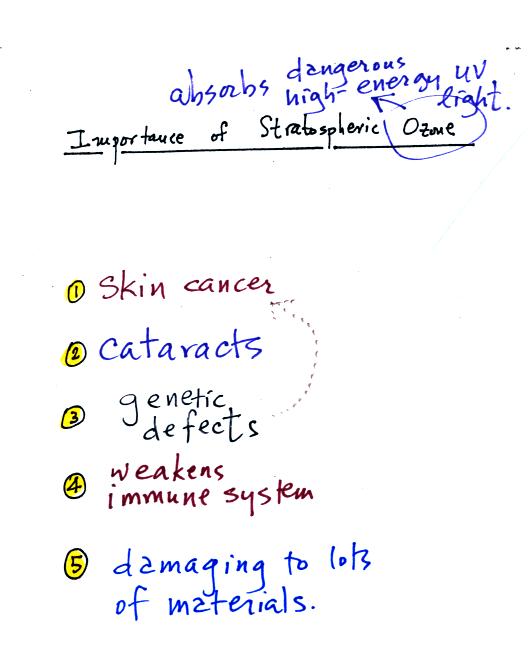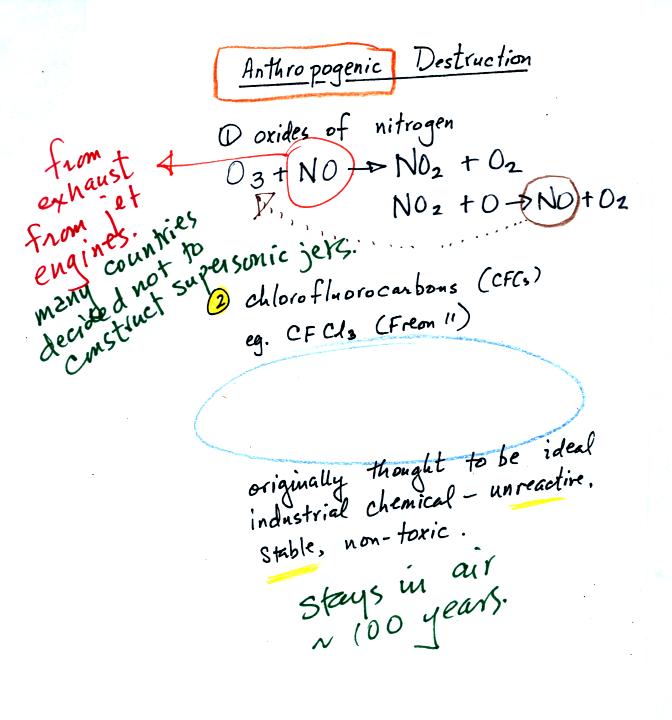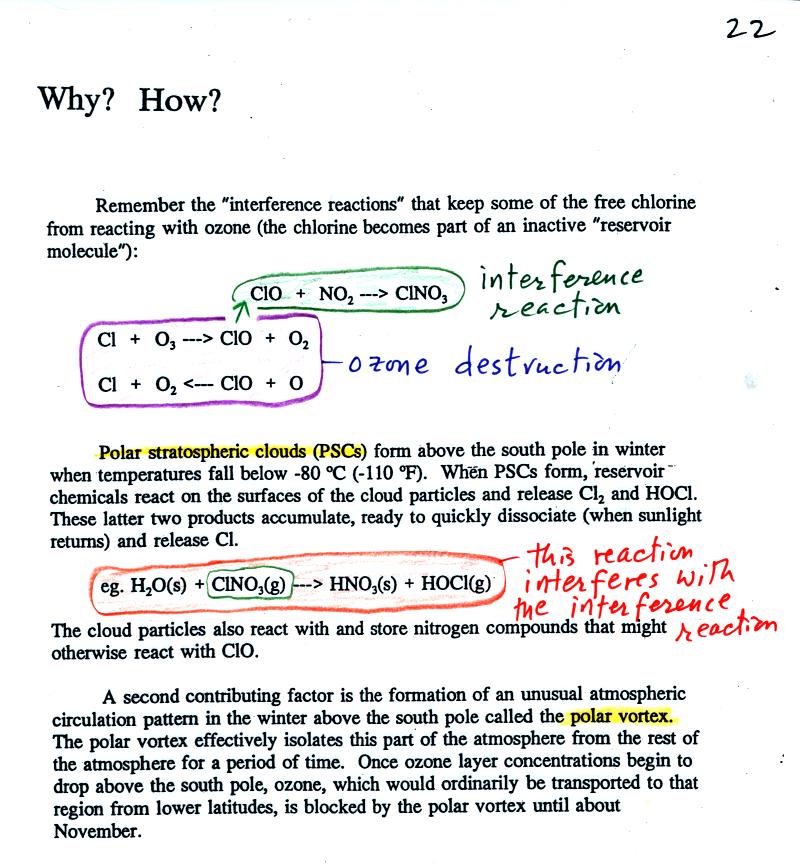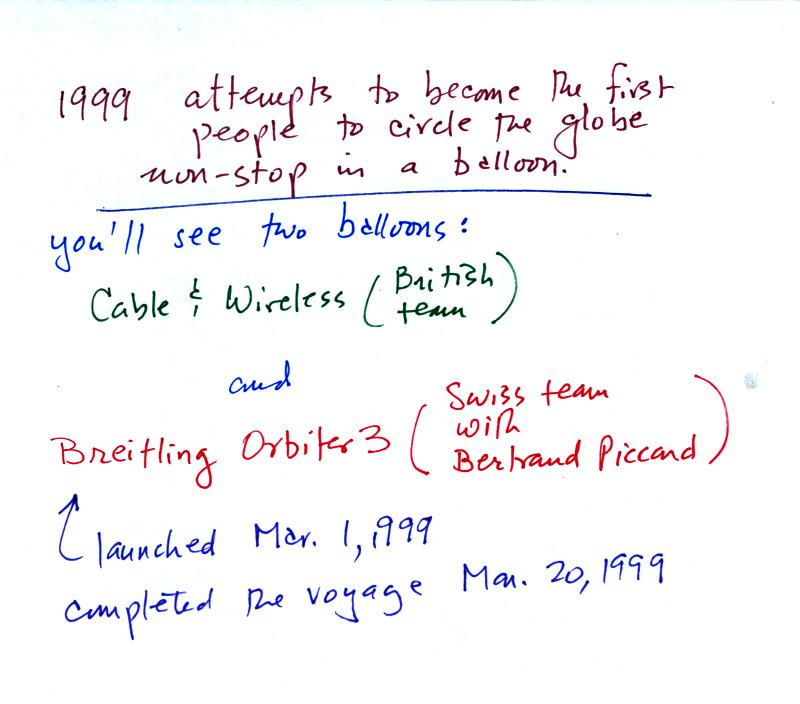Monday Feb. 18, 2008
The 2nd Optional Assignment was
collected in class today. A handout with answers to the questions
was distributed in class.
The Experiment #1 reports have been graded
and were returned. You now have two weeks to revise your report
if you wish to. Revised reports are due on Mon., Mar. 3.
Please return your original report with your revised report. You
only need to rewrite sections where you want to earn additional credit.
The 1S1P Topic #1 reports were returned today. Topic #2 reports
are starting to come back from the Teaching Assistants so they should
be returned soon.
The first real quiz of the semester is on Wednesday this week.
Reviews are scheduled for Mon. and Tue. afternoons from 4-5 pm in FCS
225. The quiz will cover material from both the Practice Quiz and the Quiz #1 Study Guides.
We'll
spend much of the period today covering stratospheric ozone.
Don't spend a lot of time studying this new material. At most
there might only be a part of a question or perhaps an extra credit
question on stratospheric ozone or the ozone hole on this week's
quiz. The figure below is from p. 17 in the photocopied
Classnotes.

Stratospheric ozone forms naturally when UV light splits
oxygen
molecules (O2) into two oxygen atoms
(photodissociation). The O atoms can
then react
with unsplit O2 to make O3 ozone. This is
the reaction we used to make ozone in the photochemical smog
demonstration.
There are also natural processes that destroy ozone. The ozone
molecule is destroyed when it absorbs UV
light and prevents the UV light from reaching the ground. Ozone
can also be destroyed
by reacting with atomic oxygen or with another ozone molecule.
The ozone layer concentration would fluctuate up and down until the
natural processes of production and destruction balance each
other. Once balance occurs the ozone layer concentration would
remain constant. The green box at the bottom of the figure above
represents this natural ozone layer concentration. Man is adding
additional processes of destruction. These will have the effect
of lowering the ozone layer concentration (symbolized above by a
smaller orange box drawn within the green box).
Once you understand how stratospheric ozone is formed you can
appreciate why the ozone layer is found not
at the bottom or
top of the atmosphere but at some level in between (at around 25 km),
where there are optimal amounts of oxygen and UV
light, the two ingredients needed to make ozone.

The ozone layer is centered around 25 km in the middle of the
stratosphere. There is plenty of UV light at higher altitudes,
but not enough oxygen. Oxygen is plentiful at lower altitudes,
but UV light is in short supply.

Stratospheric ozone, the ozone layer, absorbs much (but not
all) of the dangerous high energy ultraviolet light from the sun.
Listed above are some of the serious hazards or problems associated
with exposure to ultraviolet light.

Human activities add substances to the atmosphere that can
potentially
reduce ozone concentration in the ozone layer (which would result in
increased exposure to UV light at the ground).
The first set of reactions above involve nitric oxide, NO. First,
NO reacts with O3 to form NO2 and O2
(ordinary molecular oxygen).
Then notice the NO2 reacts with an oxygen atom (which might
otherwise
react with O2 to make O3) to form NO again and O2.
The NO is available
again to react with and destroy another ozone molecule.
At one time many countries were considering building fleets of
supersonic aircraft that would fly into the stratosphere. The
plans were scrapped partly due to concern that the NO emissions from
these aircraft would damage the ozone layer.
The main threat now comes from chlorofluorocarbons (CFCs). The
reactions involving CFCs have been copied onto the next figure.

CFCs were at one time thought to be an ideal industrial
chemical and had a variety of uses.
CFCs are unreactive, non toxic, and stable. Once they get into
the atmosphere they remain there a long time, as much as 100 years.
CFCs released at ground level [lower left corner in the figure above]
remain in the atmosphere long enough that they can eventually make
their way up into the stratophere. UV light can then break
chlorine
atoms off the CFC molecule [ upper left portion of the figure
above]. The resulting
"free chlorine" can react with and destroy ozone. This is shown
in (1) above. Note how the chlorine atoms reappears at the end of
the two step reaction. A single chlorine atom can destroy 100,000
ozone molecules.
There are ways of removing chlorine from the atmosphere. A couple
of these so called "interference reactions" are shown in (2)
above. The reaction products, reservoir molecules
(because they store chlorine), might serve as
condensation nuclei for cloud droplets (the small water drops that
clouds are composed of) or might dissolve in the
water in clouds. In either event the chlorine containing chemical
is removed from the atmosphere by falling precipitation. Clouds
are probably the most effective way of cleaning the atmosphere.

The ozone hole that forms above the S. Pole every year in late
September-early October
was one of the first real indications that CFCs could react with
and destroy stratospheric ozone. The hole is not really a hole in
the ozone layer, just a temporary thinning of the ozone layer above the
S. Pole and the continent of Antarctica. The ozone concentration
decreases to perhaps 30% of its normal value.

It is unusual to find clouds in the stratosphere. It
gets very cold above the S. Pole in the winter and polar stratospheric
clouds do sometimes form (they are made from water and other
materials). This together with an
unusual wind pattern above the S. Pole in the winter are thought to
create the ozone hole when the sun returns in the spring.
The ozone destruction reactions are shown in purple above. Cl
reacts with O3 to make ClO. This reacts with O to
produce Cl and
O2. The Cl is now available to react again with other
ozone
molecules.
In green are "interference" reactions. ClO reacts with NO2
to
make ClNO3. The Cl in this "reservoir" molecule can't
react with
any more ozone.
Now what happens above the S. Pole in the winter is that the reservoir
molecules react on the surfaces of the polar stratospheric cloud
particles to make some kind of new compound. This reaction is
shown in orange above. The new compound HOCl accumulates in the
air during the winter. When the sun reappears in the spring, the
UV light splits off all the Cl molecules which react with ozone.
A lot of chlorine suddenly becomes available and the ozone
concentration takes a nosedive.
We spent
the last few minutes of the period viewing the first successful
non-stop trip around the
globe in a balloon. Bertrand Piccard (Jacques' son, Auguste's
grandson) was part of the two man that flew the balloon. The next
page are some notes written down during that video.

There were two balloons in the air at the same time.
The lead
balloon (the Cable and Wireless balloon) crashed in the Sea of Japan
(the balloon became coated with ice in a snow storm and lost its
bouyancy). The second balloon (the Breitling Orbiter 3) balloon
avoided any mishaps. The Breitling Orbiter 3 was launched on Mar.
1, 1999 and completed its trip on Mar. 20, so it took nearly three
weeks to circle the globe.







